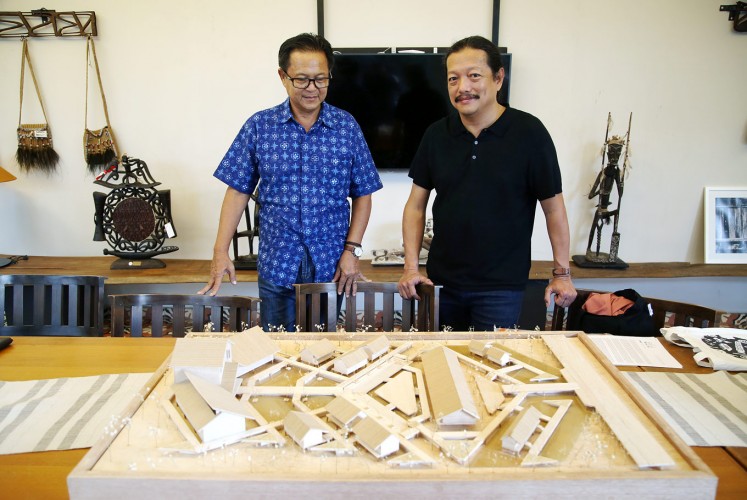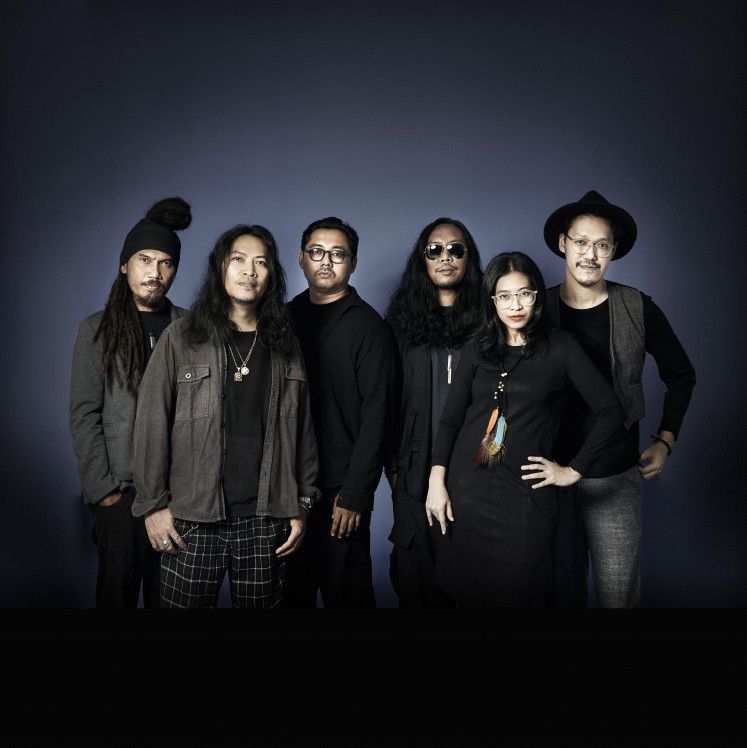Revitalizing Asmat museum and architecture
Asmat woodcarving art is the pride of the nation and a legacy that deserves a special place.
Change Size
 Hunters' story: Traditional Asmat sculptures in the Warrior Area during the Asmat Views of the World exhibition. The front sculpture depicts the hunter-gatherer call of the Asmat men. (JP/P. J. Leo)
Hunters' story: Traditional Asmat sculptures in the Warrior Area during the Asmat Views of the World exhibition. The front sculpture depicts the hunter-gatherer call of the Asmat men. (JP/P. J. Leo)
Y
ori Antar, an award-winning architect known for his efforts in preserving local building designs, is now revitalizing the Asmat Museum in Agats, Asmat regency, Papua, which is gradually succumbing to years of neglect.
The museum, managed by the Catholic Bishopric of Agats, was constructed with the help of the local community, regional administrators and Asmat woodcarvers, but they have all but abandoned the project after losing confidence in it for failing to reflect the Asmat culture.
Agats is the capital of Asmat regency located in southern Papua, directly facing the Arafura Sea. The city lies in a swampy mangrove zone and largely has stilted houses and wooden roads. Although some roads have been paved with asphalt, Agats is still known as a wooden city. In 2003, Asmat was recognized by UNESCO as a world heritage site.
“I’ve been invited to Asmat to evaluate and redesign the museum, so it can reflect the image of Asmat. The [existing] museum was built by a contractor who neglected to reflect the region’s culture in the architecture, because civil engineers are only concerned with the structural side of buildings,” Yori said, adding that woodcarvers had told him that the building was more like a storehouse to keep their works rather than a museum.
Which is why Yoris wished to develop a modern museum that honors and promotes Asmat culture, while also being part of the community.
He plans to build a new building called the Jeu House (men’s house) in the museum area. The design was inspired by a traditional Papuan house that locals believed was created by their god, Fumeripitsj. The local people build the sacred house with various ritual ceremonies called Yentpokmbu.
In front of the Jeu House, there will be a spacious yard for Asmat art and cultural shows, as well as homestay facilities. This museum area will provide a space for local youths to express their artistic zeal and develop space where artifacts can interact with visitors.

“Domestic and foreign tourists will thus have access to accommodations after visiting the Asmat Museum and observing woodcarvers work in the Jeu Houses, as well as watching art performances. Local people will also earn extra income as guides, souvenir vendors, food and beverage sellers, artists and homestay providers apart from the sale of woodcarvings,” Yori said.
In a bid to support the museum’s revamp, Yori and his Yayasan Rumah Asuh, a foundation of architects, archeologists and anthropologists, is cooperating with Yayasan Widya Cahaya Nusantara, a foundation for the preservation of art and culture under Brunoto Suwandrei Arifin, to organize an exhibition titled “Asmat Melihat Dunia” (Asmat Views the World) at the Han Awal and Partners Building in Bintaro, Tangerang, Banten, from May 6 to June 8. Sale proceeds from this event will be donated to the museum’s renovation.
“The sale of Asmat artwork will not just raise funds for the museum, but this exhibition is intended to raise public appreciation [of Asmat] by reintroducing Asmat culture to Indonesian society, especially the younger generation, so they may support the museum and the long-term preservation of Asmat art and culture. The revitalization has also been aided by some donors,” said Brunoto, an architect turned entrepreneur.
Asmat artifacts have gained the attention of various museums abroad. In Indonesia itself, Asmat woodcarvings have yet to receive public or government attention. A small portion of Asmat artworks have been displayed in a small museum located in the Papua pavilion at Taman Mini Indonesia Indah cultural park in East Jakarta.
The Asmat artwork collections overseas, such as those at the Metropolitan Museum of Art, New York; Tropen Museun, Amsterdam; and Jean Nouvel Quai Branly Museum, Paris, are well taken care of as world-class objects of art and appropriately stored.
However, Yori is optimistic that the revamped museum in Asmat will not turn into a so-called “death monument”, because statues and carvings symbolizing the presence of ancestors or venerated figures who were influential during their lifetime will be located outdoors or near sago trees to represent fertility. Smaller woodcarvings and ancestral statuettes will be placed indoors or around relevant family homes.
“That’s why I’ve redesigned the museum’s main building so as to produce the ambience of living culture instead of a death monument,” Yori said.

Yori’s efforts to preserve local architecture, which are disappearing and replaced by modern designs, earned him the 2012 Asia Pacific UNESCO Cultural Heritage Conversation Award and the Indonesian Architects Institute Award for conservation efforts.
In 2008, Yori initiated the Rumah Asuh (foster house) movement to renovate traditional Mbaru Niang houses located in the scenic mountainous areas of Wae Rebo village in Flores, East Nusa Tenggara. When first found in 1997, they were in poor condition due to old age.
Since then, Rumah Asuh has been developed into Yayasan Rumah Asuh. Backed by donors, academicians and local people, renovation programs have been carried out across the country, including Nias in North Sumatra, Sumba in East Nusa Tenggara and Central Sulawesi.
“It has the mission of preserving the archipelago’s architectural assets and has been included in the architecture education curricula of various colleges as a means of building a new mindset among members of the younger generation,” Yori said.









